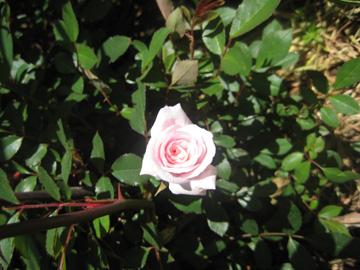Topic: Cyborg self - networked city
In a Starbucks in Newark – or maybe it is Fremont – California: not that the cities don’t have their own character, but you can’t tell if this Starbucks is on this side or that of the municipal boundary…
In Newark the buses carry advertisements for McDonalds in Hindi. The stores have signs in Vietnamese. This Starbucks however does not have signage in any language other than English, but the sound track is completely different than the sound track played in San Francisco or Mill Valley, and I don’t recognize the language.
Just finished a productive meeting with a client, and sitting in my truck, what is my next move? Next thing I need to do is finish-edit and send off proposals to two other clients. I could do that from anywhere, I don’t need to go back to Marin to do that. Nothing programmed for this evening either, so no reason to go to San Francisco.
So I am not constrained by place. I am constrained by time. The sooner the proposals go out the better, and preferably during the business day. Although what constitutes the “business day” is also loosing meaning. My client of this morning, a senior official of her organization, wryly observed that her 24-hour X 7-day schedule means that I could communicate with her at any time and she would be likely to get it and respond. And the next seat over is a middle-aged guy sound asleep in a sofa chair with his computer (off) on his lap. Snoring audibly. For him it is the middle of the night. He wakes only to mumble a response to a call on his smartphone, then he goes back to sleep.
Where we are not grounded by place, nor by time, what secures our sense of being? Starbucks and other “coffee” shops, I am coming to believe, are not the “third place” – between workplace and home. They are instead both workplace and home. At my favourite Starbucks in San Francisco – the 24-hour shop in Laurel Village – a couple of months ago, sitting next to a younger guy I’ve seen there a few times: he showed me his work, putting colour to the Marvel comics for the line drawings penned by the author-artists. These are not simple illustrations. He has no office or studio. Starbuck is his office and studio. He probably doesn’t sleep there though, as the fellow in the next seat over, getting louder and louder, and now somewhat irritating.
Where we are not grounded by place, nor by time, what secures our sense of being? There was a time when journalists were journalists because they were part of an organization that delivered news content in a world where content required an elaborate content creation organization, as Clay Shirky points out (2008 Here Comes Everybody). Today news organizations have less and less tenure over news creation and delivery but journalists are still around because they can write well and provide incisive analysis. Similarly, in such a world a place is a place, that is, anywhere is actually somewhere, because it has intrinsic character or features. In other words, it is a “sacred” space, where “sacred” means set off from the daily use-spaces that we frequent.
This is one of the reasons, I am coming to believe, that there appears to be almost a mushrooming in interest in and creation of urban farms / urban intensive agriculture / “permaculture”. An urban farm is somewhere, of course, and usually surrounded by the dense fabric of the city. As often as not an urban farm is created ex nihilo from abandoned residential or industrial land. So the farm is in great contrast to the surrounding built landscape – it is a sacred space in this sense: it is noticeably set off from the rest of city.
The nineteenth century public parks created in North America embodying the romantic landscape image of private English landscape gardens were specifically designed to improve the character of the working class population and to provide a place to re-create oneself. They were set off and designed in contrast to the industrial age city – a city of dirt or cobbled streets, horses and horse-sh, the air thick with smoke from coal fires, dense clouds of wires on poles, and according to David Henkin hundreds of billboards yammering at you and handbills floating at arms level (1998 City Reading: Written Words and Public Spaces). Urban farms are the spiritual or at least thematic descendants today of nineteenth century public parks, as a place of respite from the city, where one can "recreate" oneself and refresh … Urban farms are also usually community institutions, run by and for communities, so they also embody place in this way: they manifest in one place a host of personal and extended relationships, and are sacred for this reason as well.

 At long last the heritage rose in Tennessee Valley has bloomed, has not been eaten by a deer, and I was there with a camera. Here are pics. Very powerful and lush
At long last the heritage rose in Tennessee Valley has bloomed, has not been eaten by a deer, and I was there with a camera. Here are pics. Very powerful and lush  fragrance. Overall about 3cm / little over an inch.
fragrance. Overall about 3cm / little over an inch. 